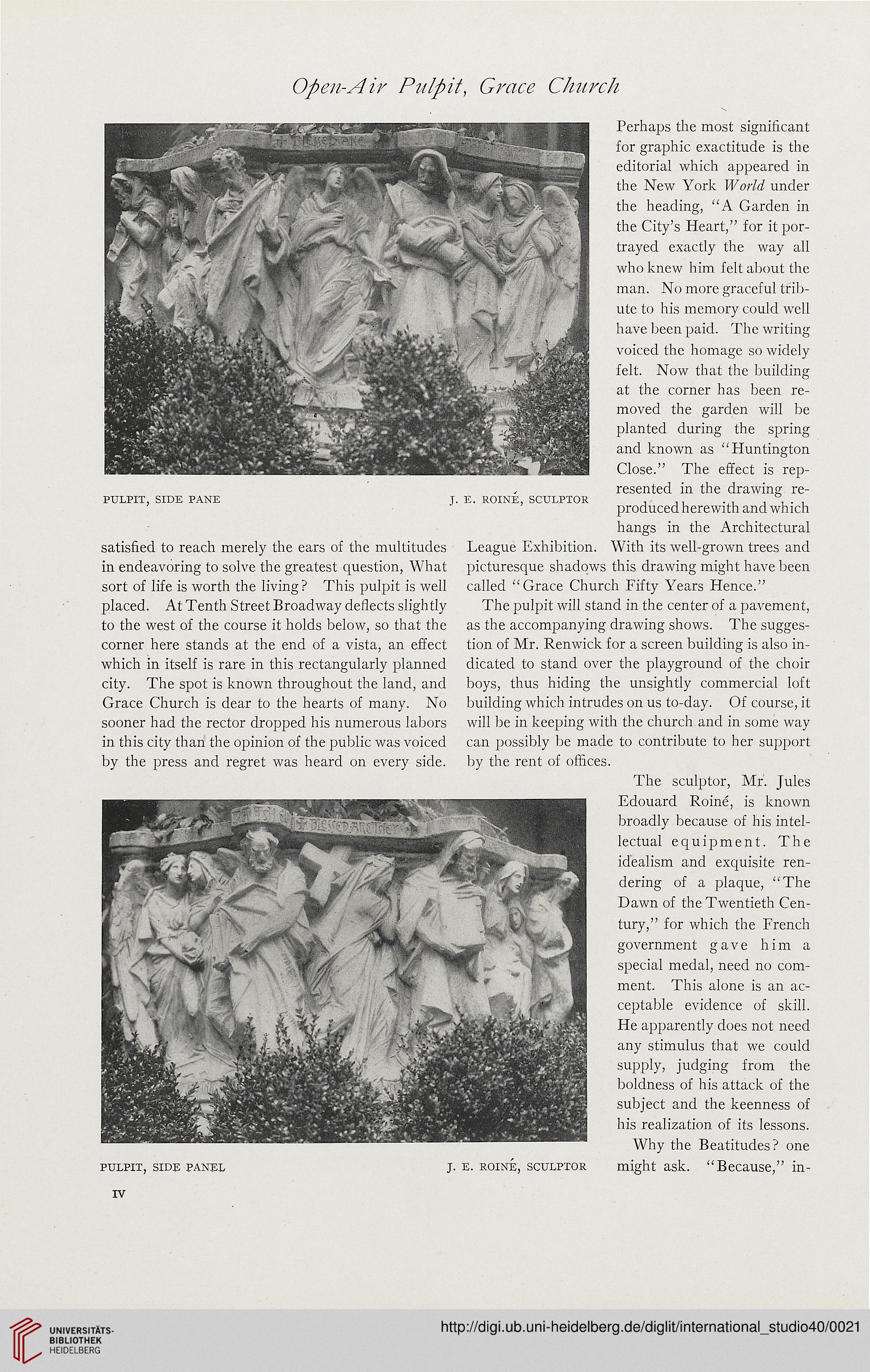Open-Air Pulpit, Grace Church
Perhaps the most significant
for graphic exactitude is the
editorial which appeared in
the New York World under
the heading, "A Garden in
the City's Heart," for it por-
trayed exactly the way all
who knew him felt about the
man. No more graceful trib-
ute to his memory could well
have been paid. The writing
voiced the homage so widely
felt. Now that the building
at the corner has been re-
moved the garden will be
planted during the spring
and known as "Huntington
Close." The effect is rep-
resented in the drawing re-
pulpit, side pane j. e. roine, sculptor ,< . . . , , , . ,
produced herewith and which
hangs in the Architectural
satisfied to reach merely the ears of the multitudes League Exhibition. With its well-grown trees and
in endeavoring to solve the greatest question, What picturesque shadows this drawing might have been
sort of life is worth the living? This pulpit is well called "Grace Church Fifty Years Hence."
placed. At Tenth Street Broadway deflects slightly The pulpit will stand in the center of a pavement,
to the west of the course it holds below, so that the as the accompanying drawing shows. The sugges-
corner here stands at the end of a vista, an effect tion of Mr. Renwick for a screen building is also in-
which in itself is rare in this rectangularly planned dicated to stand over the playground of the choir
city. The spot is known throughout the land, and boys, thus hiding the unsightly commercial loft
Grace Church is dear to the hearts of many. No building which intrudes on us to-day. Of course, it
sooner had the rector dropped his numerous labors will be in keeping with the church and in some way
in this city than the opinion of the public was voiced can possibly be made to contribute to her support
by the press and regret was heard on every side, by the rent of offices.
The sculptor, Mr. Jules
Edouard Roine, is known
broadly because of his intel-
lectual equipment. The
idealism and exquisite ren-
dering of a plaque, "The
Dawn of the Twentieth Cen-
tury," for which the French
government gave him a
special medal, need no com-
ment. This alone is an ac-
ceptable evidence of skill.
He apparently does not need
any stimulus that we could
supply, judging from the
boldness of his attack of the
subject and the keenness of
his realization of its lessons.
Why the Beatitudes? one
pulpit, side panel j. e. roine, sculptor might ask. "Because," in-
IV
Perhaps the most significant
for graphic exactitude is the
editorial which appeared in
the New York World under
the heading, "A Garden in
the City's Heart," for it por-
trayed exactly the way all
who knew him felt about the
man. No more graceful trib-
ute to his memory could well
have been paid. The writing
voiced the homage so widely
felt. Now that the building
at the corner has been re-
moved the garden will be
planted during the spring
and known as "Huntington
Close." The effect is rep-
resented in the drawing re-
pulpit, side pane j. e. roine, sculptor ,< . . . , , , . ,
produced herewith and which
hangs in the Architectural
satisfied to reach merely the ears of the multitudes League Exhibition. With its well-grown trees and
in endeavoring to solve the greatest question, What picturesque shadows this drawing might have been
sort of life is worth the living? This pulpit is well called "Grace Church Fifty Years Hence."
placed. At Tenth Street Broadway deflects slightly The pulpit will stand in the center of a pavement,
to the west of the course it holds below, so that the as the accompanying drawing shows. The sugges-
corner here stands at the end of a vista, an effect tion of Mr. Renwick for a screen building is also in-
which in itself is rare in this rectangularly planned dicated to stand over the playground of the choir
city. The spot is known throughout the land, and boys, thus hiding the unsightly commercial loft
Grace Church is dear to the hearts of many. No building which intrudes on us to-day. Of course, it
sooner had the rector dropped his numerous labors will be in keeping with the church and in some way
in this city than the opinion of the public was voiced can possibly be made to contribute to her support
by the press and regret was heard on every side, by the rent of offices.
The sculptor, Mr. Jules
Edouard Roine, is known
broadly because of his intel-
lectual equipment. The
idealism and exquisite ren-
dering of a plaque, "The
Dawn of the Twentieth Cen-
tury," for which the French
government gave him a
special medal, need no com-
ment. This alone is an ac-
ceptable evidence of skill.
He apparently does not need
any stimulus that we could
supply, judging from the
boldness of his attack of the
subject and the keenness of
his realization of its lessons.
Why the Beatitudes? one
pulpit, side panel j. e. roine, sculptor might ask. "Because," in-
IV




